You have to replace your agricultural tyres regularly as a result of wear, and this major investment will obviously be less painful if it occurs less often. As wear is the key on which the tyre replacement depends, the best thing would be to slow it down by defining what has the greatest impact on this wear and what levers could be acted upon to slow it down as much as possible. So yes, there are many causes of wear, but certain are more frequent than others and sometimes more rapid.
In this article we will look at the most frequent causes of wear and see if we can define an order of importance for the principal causes of wear:
1. Wear over which you have no influence
There are many causes of tractor tyre wear, certain of which can damage your agricultural tyres rapidly, irrespective of your user habits and mechanical settings.
Wear linked to the type of ground on your farm
No matter what the configuration of your farm is, you will use your tractor on very different types of ground: the court farmyard, the tracks you drive on, the road trips you make each day or the land in your fields, each of these surfaces can have a negative impact on tyre wear.
The type of soil and quality of the earth on your farm is likely to have a greater impact if you work with field crops. Earth is effectively more or less abrasive depending on your region:
- If you work on soft, sandy, silty or clay-loam soil, for example, wear linked to the type of soil will be relatively low.
- On the other hand, limestone soil can alter your tyres prematurely depending on the limestone grain size and the quantity of limestone particles in your fields.
- If you work on flint or stony soil, wear will be very rapid. Certain stones may be as sharp as glass and cause cuts or scratches to the lugs of your tractor tyres, however robust they may be, which will be even worse if your land is hilly.
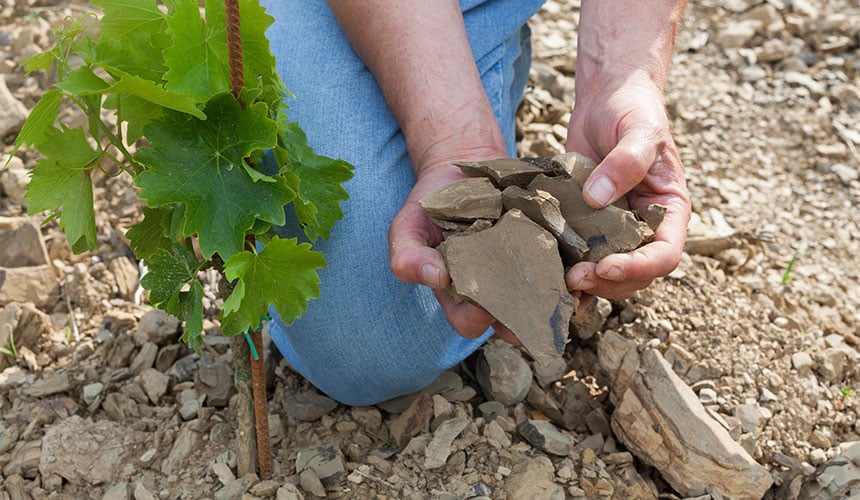 Wine growing soil causing rapid tyre wear
Wine growing soil causing rapid tyre wear
- Other types of land may accelerate wear to agricultural tyres, which is the case in particular for wine growing areas where the land is often very hard and sloping. These specific crop-growing areas require the use of specially adapted tyres, because standard agricultural tyres are essentially designed for work on soft, loose soil. For example, Firestone’s R4000 has been specifically developed for vineyards, with its robust casing and greater resistance thanks to the brand’s anti-wear rubber compound.
Wear linked to the distance covered by road
A tractor tyre, by nature, is not meant for use on the road. Yet it seems that agricultural tractors spend more and more time on the road, particularly due to the distance between fields. If you cover many kilometres on the road each week with your tractor, your tyres’ lifespan is likely to be reduced rapidly.
Road surfacing is much harder than earth and its components make it abrasive like sandpaper. It contains highly aggressive materials: tar, crushed rocks and gravel which form a sprinkling of rough, sharp surface irregularities. The tips of the lugs crush into the minuscule abrasive fragments in the ground (indentation) rubbing away tiny particles of rubber during movement, in order to grip the ground. Driving for several hours on the road will inevitably lead to more rapid wear to your tractor tyres.
2. Wear over which you have control
Tractor tyre wear is not a fatality or just a matter of product brand, but a factor over which you can have a major influence, leading to considerable savings for your farm.
Here are the factors that you can control or modify to gain several thousand hours more use of your tyres.
Wear linked to use on surfaces that are too hard or unsuitable use of the tyre model
The use of a car tyre is basically always the same for most drivers: driving at a controlled speed, almost 100% on asphalt.
This use, common to almost all cars, leads to an incorrect perception of the use of agricultural tyres, which is much more technical and very different depending on the purpose intended by the tyre manufacturer.
Each agricultural activity requires tools that are adapted, so that the work can be done in the best possible conditions and this is exactly the same for an agricultural tyre.
Just like with your tools, there is a tyre for each use:
For work in the fields, tyres are designed with a structure and rubber that is supple, to work on soft soil. They are perfectly suitable for field crop farming, but much less so for various manoeuvres in the farm courtyard where the ground is very hard. Whether you work with a tractor equipped with a front loader or telescopic arm, you must use suitable tyres which guarantee more resistance and better stability. They must be able to withstand the strain of frequent on-the-spot manoeuvres, with heavy loads, which are transferred to the tractor’s front axle.
If you drive a lot on the road, if you work frequently in the farm courtyard or in buildings, you must have more resistant tyres to avoid them wearing too rapidly.
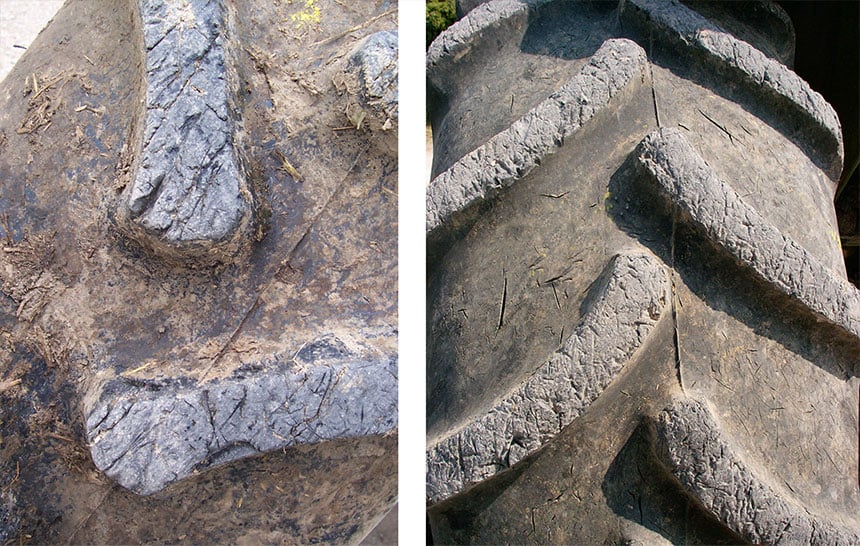 Use of agricultural tyres on too hard a surface
Use of agricultural tyres on too hard a surface
These days there are agricultural tyres designed specifically for each use:
- The MAXI TRACTION IF will be ideal for soil preservation purposes in the fields with a good traction capacity.
- The PERFORMER Extra 70 will be ideal for resistance to wear during frequent use for transport by road.
- The PERFORMER 95 will be ideal for spraying operations with a steel chord belt to counteract heavy loads.
- The R8000 UTILITY will be ideal for heavy use on a loader for example.
- The DURAFORCE UTILITY will be ideal for heavy use in handling operations in the farm courtyard.
Wear linked to a mechanical fault
Of the principal causes of wear to agricultural tyres, mechanical faults are among the most frequent, particularly those linked to geometry:
Wear linked to a problem with parallelism
Parallelism corresponds to the left/right alignment of the wheels relative to each other. Ideally, your tyres should be perfectly parallel to the vehicle’s centreline.
There are two types of problem with parallelism:
- Toe-in: this occurs when the front of the tyres point inwards compared to the tractor’s centreline. This setting error inevitably causes the tyre to wear on the outside.
- Toe-out: inversely, we talk about toe-out when the front of the tyres point outwards compared to the tractor’s centreline. In this case, wear is more pronounced on the inside of the tyres.
Wear linked to problems with camber
As opposed to parallelism, camber is the tilt of the top of the wheel inward or outward in relation to the true vertical. For this setting to be perfect, your tyre should be completely vertical, which is to say as flat as possible on the ground.
There are two types of problem with camber:
- Positive camber: this occurs when the top of the tyres tilt away from the vehicle. In this case there will be more wear to the outside part of the tyre.
- Negative camber: this is when the top of the tyre tilts inwards. As the wheels are further apart at the bottom, there is more wear to the inside edge of the tyres.
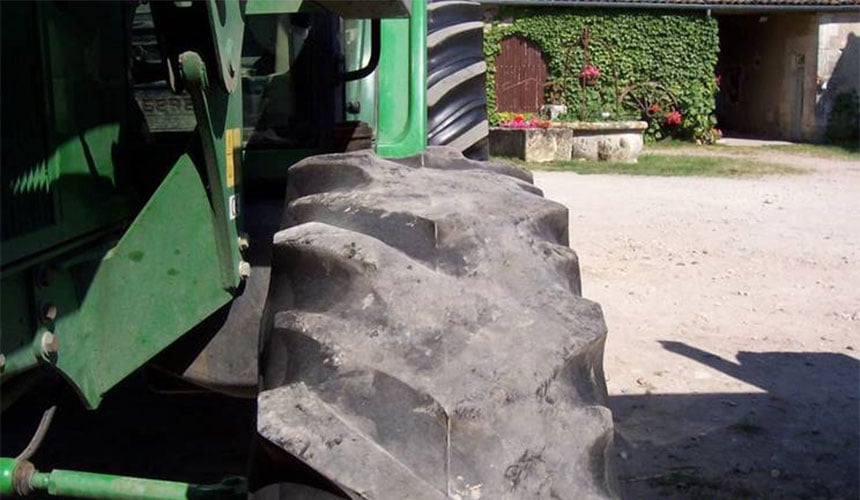 Wear linked to positive camber
Wear linked to positive camber
Wear linked to problems with lead
Lead/lag is the synchronisation of the front and rear axle of the tractor based on tyre size. A correct lead setting must result in slightly more front traction than at the rear. If the front tyres wear more rapidly than the rear tyres, there is a good chance you have a problem with the lead ratio.
Wear linked to an unsuitable inflation pressure, load or speed
Tyre wear may be caused by an incorrect pressure setting for your load:
- Underinflation: an insufficient inflation pressure for the load carried results in your tyre’s constituent materials heating, thus damaging the rubber compound.
- Overinflation: the tyre bows out and only the central part is solicited, which increases wear to the tread at the level of the lug base. The tyres will wear more rapidly if you carry heavy loads on the road.
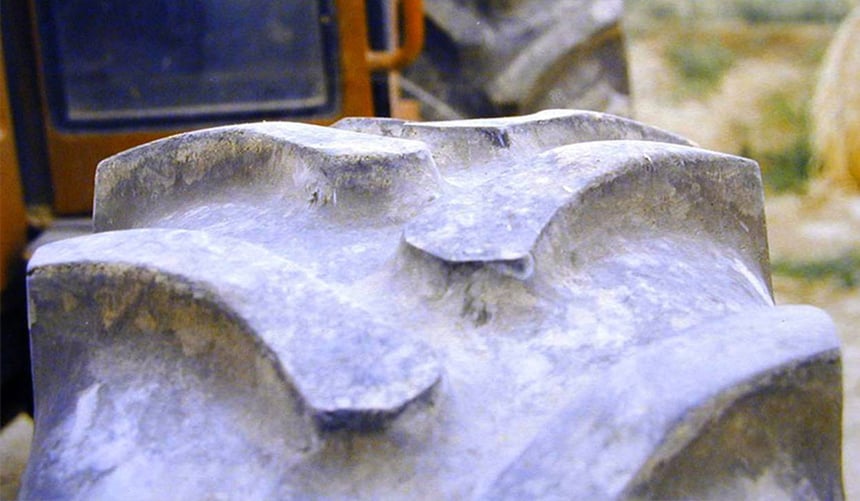 Central wear linked to overinflation
Central wear linked to overinflation
Speed has a high impact on wear
Tyre wear is directly affected by speed, and drivers tend not to respect the speed recommended for the load and pressure settings adopted when the tractor is stationary, before the start of operations.
- If you have a tendency to drive fast on the road or tracks: the temperature of the rubber will rise, making it more supple and therefore more sensitive to abrasion on the road. Speed means that you will slip slightly in the bends, which will have a higher impact on tyre wear.
- What we may term “aggressive” driving, with quick accelerations and frequent sudden and prolonged braking will be very damaging for your tyres, as well as increasing your fuel consumption.
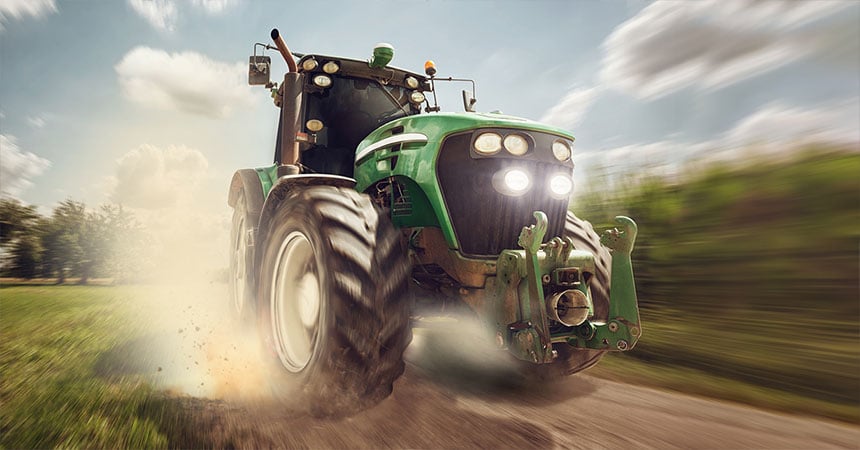
- If you chose to drive more slowly and flexibly on the road you will slow down the abrasion of the rubber by the asphalt which will limit wear to your tractor tyres.
3. Can types of wear be classified by order of importance?
No, we cannot really classify causes of wear by order of importance, because generally they are all combined and it depends essentially on your type of farm: field crops, wine growing, polycropping/livestock farming…. etc. or your daily use which may differ considerably depending on your farming profile.
On the other hand, you can avoid or reduce the causes of tyre wear which correspond to you in the list above and above all choose tyres that are more suitable, and wear resistant, if you have a more heavy use of your equipment.
To help you clearly define the causes of premature wear on your current tyres, we have developed a complete guide for you to download free of charge "How to detect abnormal wear in my tractor tyres"

Most people who read this article have also read some of the following articles:
This information is intended only to make you aware of the technical and functional aspects of agricultural tires and their use. It does not allow you to make a judgment or a definitive conclusion on a given problem. Only your agricultural tire expert is able to make a technical assessment and take a final decision, case by case.